Beneficial Use of Dredged Material: A Win-Win for Coastal Restoration Projects
By Dr. Ram Mohan, Anchor QEA’s Principal Engineer and Adjunct Professor at Texas A&M
Dredging and dredged material management in today’s regulatory environment can be both challenging and expensive, especially as traditional methods of dredged material placement become harder to design and construct. But there’s a silver lining to this problem: reusing dredged sediments on eroding and damaged marshes is an optimal approach to improving coastal resilience, working with the natural system, and providing long-term, sustainable results.
Exploring the Beneficial Use of Dredged Material
Beneficial use (BU) of dredged material is essentially using dredged sediments as a natural resource in a productive way, thereby providing environmental, economic, or social benefits. It provides a multifaceted solution to the challenges of managing sediments removed from routine dredging of recreational and commercial navigation channels. BU facilitates cost-effective dredging as well as a low-cost and environmentally protective solution to our eroding and vanishing coastal marshes. BU has been used to restore salt marshes throughout the Gulf of Mexico since the early 1980s and is increasingly being recognized as the optimal method to improve coastal resilience and ecosystem functions of wetlands throughout the United States.
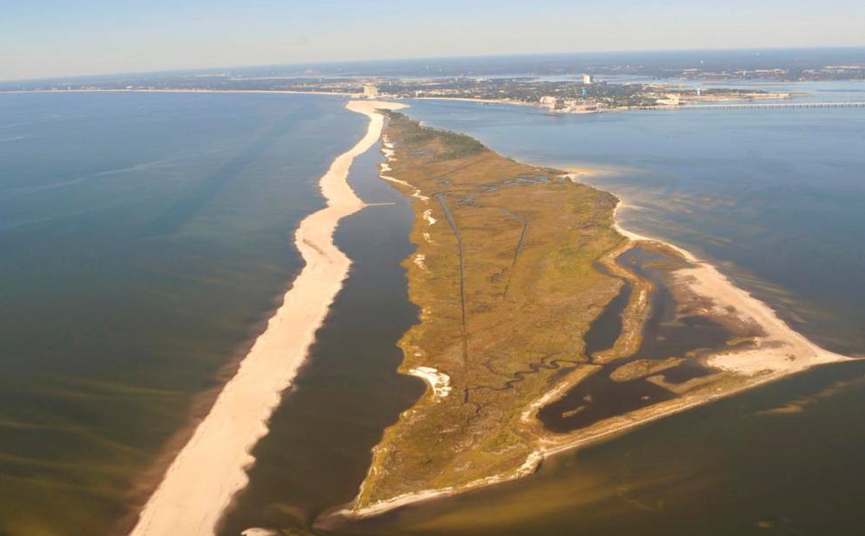
Deer Island Restoration, Mississippi
Placing a layer of dredged material onto salt marsh surfaces raises the elevation, countering rising sea levels and marsh subsidence, while still maintaining optimal conditions for low or high marsh habitat. Encouraged by the placement of dredged material, the resulting healthy vegetation stabilizes the marsh by preventing it from drowning, and it arrests edge erosion (especially when combined with erosion–protection systems such as living shorelines). These marsh systems provide the long-term benefits of coastal protection, improved ecosystem functions, and water filtration.
Site Selection Criteria for Beneficial Use Projects
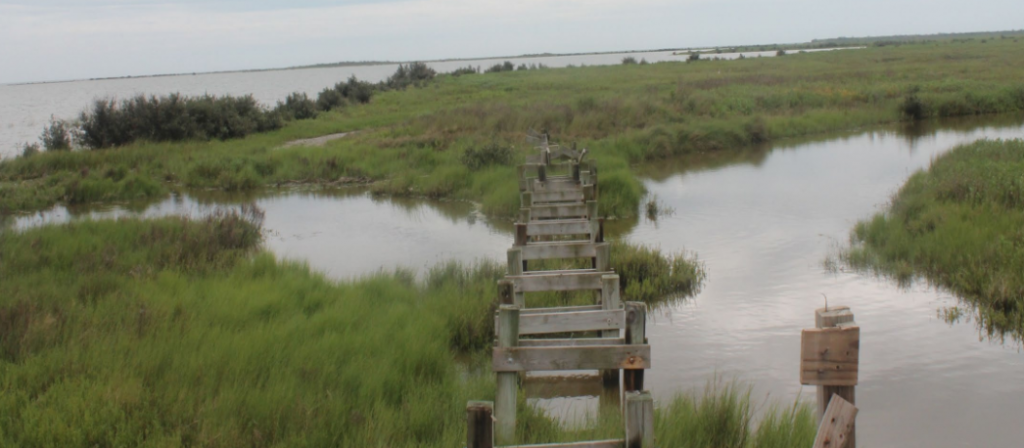
Bolivar Marsh, Texas
For projects where the ultimate goal is to restore ecosystem functionality, the challenge is to modify the site to ensure that the conditions are suitable for wetland habitat. Developing a fully functional wetland system requires determining a set of applicable baseline conditions, through nearby reference marsh studies, so that basic restoration parameters can be defined. These parameters then provide the target design criteria for restoration and therefore guide material placement and site management activities. A process for evaluating potential sites and the design process is illustrated below.
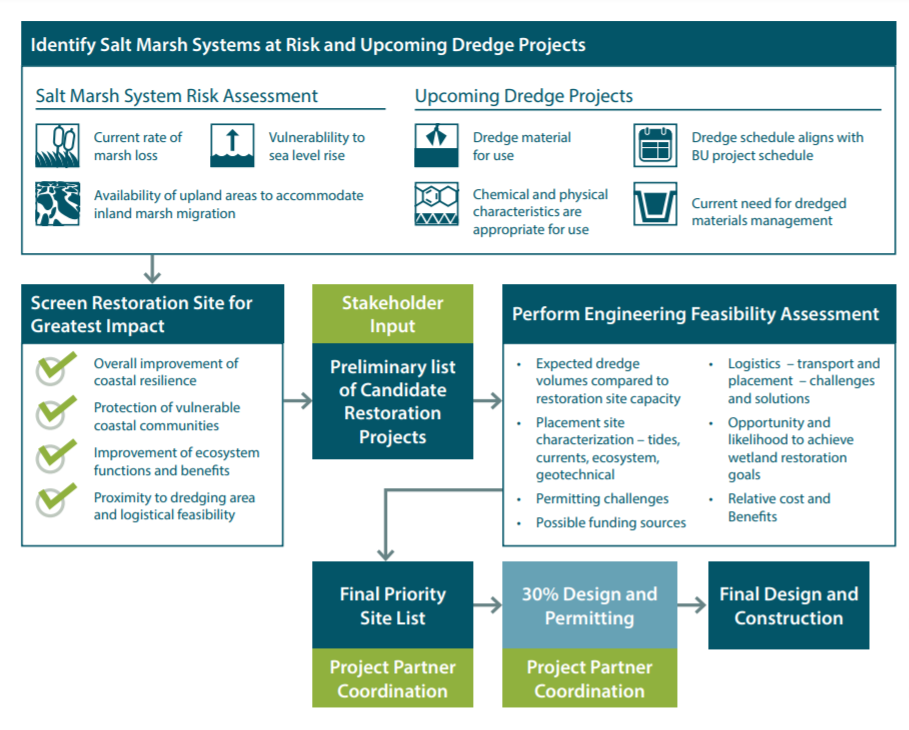
Various dredging site information can be gathered and evaluated using the approach presented (see figure, below), and, depending on site–specific screening criteria, an initial priority list of best restoration sites and ideal dredging sites (for best source material) can be developed. This can then be coupled with the planned dredging cycles and time frames to arrive at an overall site development plan.
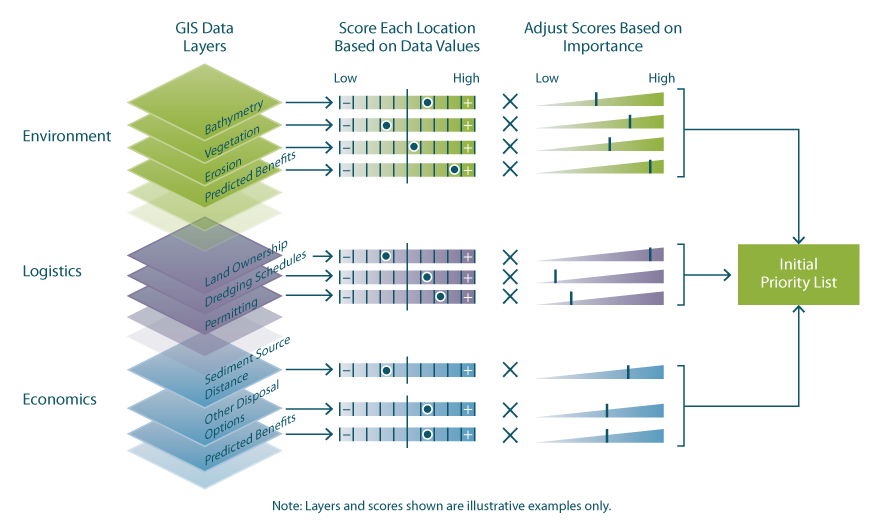
Beneficial Use in the Gulf Coast: Texas
Texas is losing coastal wetlands at an alarming rate of more than 5,700 acres annually, leaving the Gulf Coast at a net loss of 257,150 acres. This accounts for 71% of the estimated wetland loss from coastal watersheds in the US and is primarily due to insufficient sediment supply in the coastal system. Considering the vital nature of dredging to maintain the Houston Ship Channel and other federal channels, BU is an ideal use of the sediments generated by dredging by the U.S. Army Corps of Engineers, Port of Houston, and other private industries.
Coastal Restoration: Timelines and Benefits
BU has the potential to restore thousands of acres of currently degrading coastal habitat annually, specifically in the USACE Galveston District. Based on the annual dredged material quantity (21.3M cy) for active construction maintenance dredging projects in this area, and typical application depths of 2 to 5 feet. The thinner the placement lift of dredged material, the faster the natural recovery of the marsh vegetation. With thicker applications (i.e., those exceeding 12 inches), seeding or planting will be required post-placement to jump–start vegetative recovery. Recovery time frames of 2 to 4 years for these types of applications are often required and coupled with adaptive management principles to let natural processes drive the recovery, to the extent feasible.
BU provides many benefits, including the economic value in ecosystem services and commercial value in maritime, fishing, and wildlife revenue. However, implementing BU can be challenging; in particular, permitting such projects ahead of dredging events can be time-consuming, complicated, and expensive. Therefore, early stakeholder and regulatory coordination is key for successful outcomes of such projects.
Beneficial Use in Action: Hurricane Ike Recovery in the Houston-Galveston Navigation Channel
Planning and prioritization efforts that improve and streamline the BU project process are the best way to capitalize on the significant potential for coastal restoration inherent in new or maintenance dredging.
Anchor QEA teamed with AECOM, a USACE consultant, to develop the design-build contract packages for Hurricane Ike recovery projects—one of the first design-build dredging and habitat development contracts in Texas. These design-build packages included evaluating multiple sites needing repair and restoration after the hurricane, including identifying site-specific repairs, enhancing the original designs, and cost engineering and constructability requirements. The sites included traditional upland and marsh development placement areas, a bird island, and habitats constructed as part of the Houston-Galveston Navigation Channel widening and deepening project.
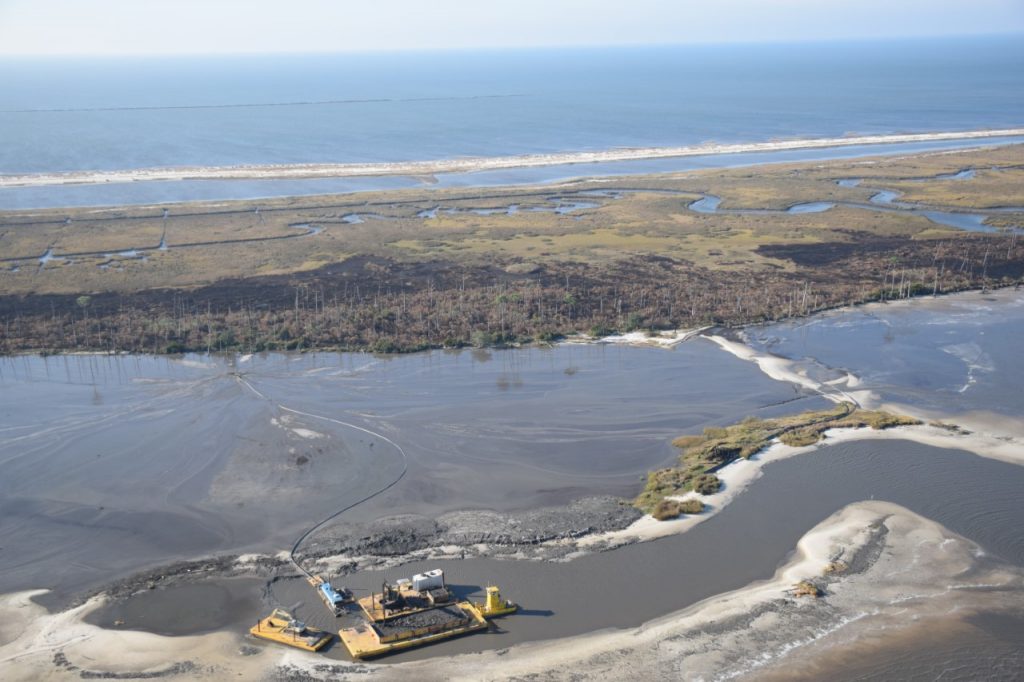
Anchor QEA led the Beneficial Use Group coordination for the team. The Anchor QEA/AECOM team provided technical and strategic advice to the USACE regarding design-build methods and data required to efficiently implement such contracts. As a result, the District awarded the Anchor QEA/AECOM team the channel improvements contract package for the Texas City Channel, which involved BU for structural fills and habitat development. A nontraditional Dredged Material Management Plan was implemented using a majority of the dredged materials to develop and replace structures and habitats lost or damaged by Hurricane Ike. Anchor QEA’s team addressed the unique challenges of the coastal environment, minimized impacts during construction, and provided value-added project management and engineering design.

